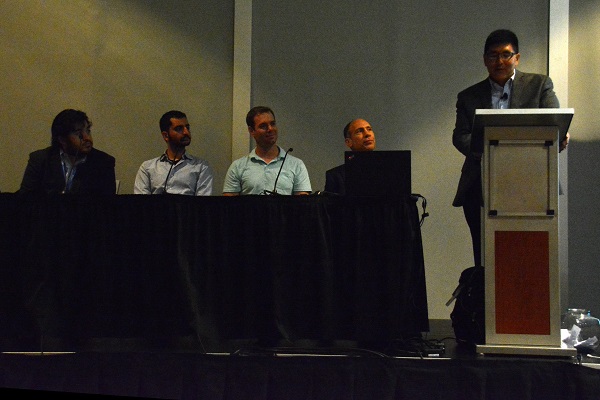by Dot Cannon
What needs to happen, before autonomous vehicles can become an everyday reality?
That was the focus of a brand-new “Automotive and Autonomous Vehicles Sensors Workshop” at the 2017 Sensors Expo and Conference in San Jose on Wednesday morning.

During the workshop, coordinator Will Tu , who is DSP Concepts’ Executive Vice President, discussed the topic with three separate discussion panels. And each panel explored a different aspect of the issues involved.

After Panel One’s discussion of “Processing, CPUs and Analysis”, Panel Two was seated. For the next fifty minutes, they’d be talking about “Machine Learning and Software”.
Panel Two’s Perspective

Aesthetics for the consumer was a consideration which Algolux Vice-President of Business Dave Tokic raised in his introductory remarks.
As the industry’s first automation platform to optimize computer image quality tuning through machine learning , he said, Algolux had two competing objectives. Improved image processing for cameras and computer vision systems wasn’t necessarily appealing to the human eye.
“A properly tuned image looks pretty ugly to a human but contains the data an algorithm is looking for,” Dave explained. “(With machine learning,) we’re showing 30 to 40 percent (improvement) in image processing.”

“We’re like an old-timer in the autonomous-vehicle industry,” said PolySync co-founder and CEO Josh Hartung, introducing his company. “We’ve been around for five years.”
Josh said that he saw the autonomous vehicle industry entering a period of refinement. But like the Panel One speakers, Josh pointed to an area where much more research was needed. Citing the Google car, he said, “You can’t make any claims on safety from a couple million miles. You need to get into the billions.
“That is the next big blocker in autonomous driving, is safety.”

Specifically, he said, autonomous cars needed to allow room for the unexpected.
“We need to be able to fail and get off the road safely…The thing that we’re focused on, is how do we achieve that level of reliability?”
Mapping for autonomy

“At Civil Maps, what we do is cognition for cars,” said Civil Maps founder and VP of Research Fabien Chraim, “and we do that through crowdsourcing.”
Fabien explained that Civil Maps’ technology overlays a 3D semantic map. Vehicle sensor data automatically updates the information, positioning an autonomous vehicle on it in real time.

“The costs on collecting data for machine learning are astronomical,” said XCube Communication CEO Satish Jha in his opening remarks. “And it’s very difficult to figure out what the right tool for machine learning is.
“We tried to create a simple, easy-to-use product to create algorithms that someone (without much experience with algorithms can use).”

“All of you guys are relatively small companies,” Will commented to the panel. “Why does (the autonomous-vehicle industry) need guys like you to come into this marketplace?”

“I think we as smaller companies can innovate quickly, fail quickly and recover quickly,” Dave responded. “I think…there’s also a personality, that’s been bred over decades and decades and decades of cautious innovation.”
“It’s a difficult time to be an OEM (original equipment manufacturer) or a Tier 1,” Josh added. “It’s a challenge (for these large companies) to address the newest and best stuff. I think that’s a match made in heaven. In the startup side, we can do the tech innovation quickly, and the OEM can collaborate.”

“One nice thing about working in Silicon Valley,” Fabien said, “is that there’s a trust coming from these big companies towards these startups (that you don’t find elsewhere).”
The challenges ahead
Next, the panel discussed the challenges to machine learning and autonomous vehicles.
The safety factor came up immediately.

“In some cases, you may be using machine learning. In other cases, you’re using cryptographic principles to improve safety,” Josh said. “We’re working at a level of computing and safety criticality that is completely unprecedented.”

“We’re seeing a lot of companies that are focusing on improving those frameworks,” Fabien said. “I think one of those challenges is, we need the framework to evolve.”
Another challenge, the group said, was the fact that autonomous vehicle creation ventures into so many unknown areas.

“I think one of the things that’s been driven is specialization,” Dave commented. “Any unknown or error that occurs in one area will go to the next area.”

“Anyone can open Python,” Fabien said. “But…we need to work out these new skills, these new tools.”

Will summed up the comments: “What I kind of hear from the panel, is that validation is a big issue, and also, there’s a maturity curve.”
During the Q and A session, one audience member wanted to know, “What about the government’s role, setting standards, to help define the validation process?”
Again, the element of “unknown” came up.

“Even if you were to attempt to define something as safe, we don’t know what that looks like,” Satish said. “At a conceptual level, we’re much further behind than we think we are.”

“I don’t think the government’s going to define much here,” Josh commented. “Historically, the automotive industry is (self-regulated).”
With all the unknowns and challenges, though, Josh said the industry was still moving steadily towards its goal.
“You’re talking autonomous cars by 2021, (or) 2025.”
